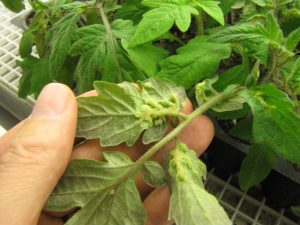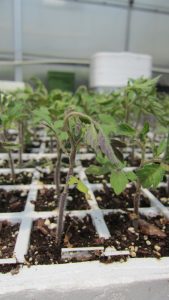Tomatoes grown in controlled environment are exposed to conditions that are different from their original habitats. As a result, varieties that are not specifically bred for greenhouse production may respond to the controlled environment with abnormal symptoms. One group of the symptoms is called edema. Bumps, galls or blisters develop on tomato leaves, petioles or stems (Figure 1). In severe conditions, it causes leaf curling, distortion and abscission (Figure 2). A couple of factors including high humidity, excessive water in the soil, air pollution, and low light condition could cause the symptom. Tomato varieties respond differently in susceptibility to the physiological disorder, and the primary contributing factors can also be different among tomato varieties.
The most severe case of edema that we have observed so far is on tomato rootstocks including ‘Maxifort’. This is not surprising as most of the commercial tomato rootstocks are hybrid of wild tomatoes Lycopersicon esculentum and L. hirsutum. Both of the species are highly susceptible to the physiological disorder. We noticed a dramatic difference of ‘Maxifort’ grown in two greenhouses. One of them is made of polycarbonate that has 18% of UV light transmittance, the other one is made of polyethylene with 80% of UV light transmittance. Edema developed on ‘Maxifort’ that are grown in the polycarbonate greenhouse at the time when plants had 3-5 true leaves. However, the symptom was not observed on ‘Maxifort’ grown in the polyethylene greenhouse. A study conducted at University of Wisconsin confirmed that the primary contributing factor for edema on ‘Maxifort’ is due to lack of ultraviolent light, while soil moisture affect severity of the symptom to a smaller extent.
If the rootstocks show edema symptom, can they still be grafted? As a general rule, we do not want to graft plants that are diseased or stressed. However, edema is not contagious, and it can be managed by exposing plants to full sunlight if the symptom is detected in an early stage. If the symptom is reduced, those rootstock plants can still be used in grafting. However, if the symptom is at an advanced stage that leads to abscission of most of the leaves, those plants can not be grafted.

